Related Research Articles
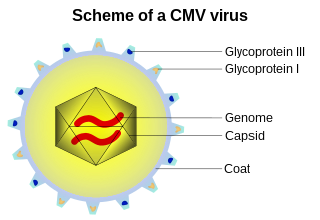
A capsid is the protein shell of a virus, enclosing its genetic material. It consists of several oligomeric (repeating) structural subunits made of protein called protomers. The observable 3-dimensional morphological subunits, which may or may not correspond to individual proteins, are called capsomeres. The proteins making up the capsid are called capsid proteins or viral coat proteins (VCP). The capsid and inner genome is called the nucleocapsid.
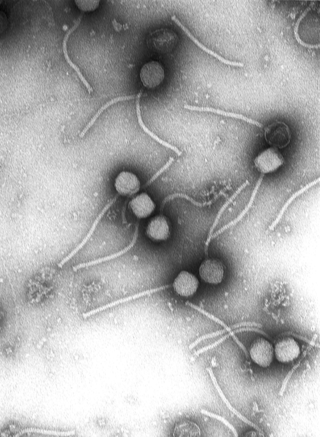
Virology is the scientific study of biological viruses. It is a subfield of microbiology that focuses on their detection, structure, classification and evolution, their methods of infection and exploitation of host cells for reproduction, their interaction with host organism physiology and immunity, the diseases they cause, the techniques to isolate and culture them, and their use in research and therapy.

Rosalind Elsie Franklin was a British chemist and X-ray crystallographer whose work was central to the understanding of the molecular structures of DNA, RNA, viruses, coal, and graphite. Although her works on coal and viruses were appreciated in her lifetime, Franklin's contributions to the discovery of the structure of DNA were largely unrecognized during her life, for which Franklin has been variously referred to as the "wronged heroine", the "dark lady of DNA", the "forgotten heroine", a "feminist icon", and the "Sylvia Plath of molecular biology".
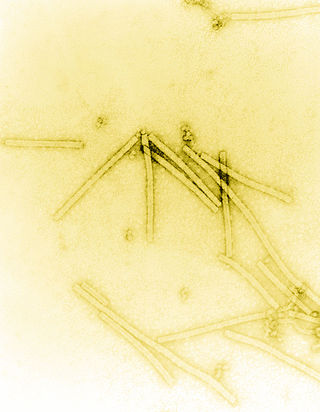
Tobacco mosaic virus (TMV) is a positive-sense single-stranded RNA virus species in the genus Tobamovirus that infects a wide range of plants, especially tobacco and other members of the family Solanaceae. The infection causes characteristic patterns, such as "mosaic"-like mottling and discoloration on the leaves. TMV was the first virus to be discovered. Although it was known from the late 19th century that a non-bacterial infectious disease was damaging tobacco crops, it was not until 1930 that the infectious agent was determined to be a virus. It is the first pathogen identified as a virus. The virus was crystallised by Wendell Meredith Stanley. It has a similar size to the largest synthetic molecule, known as PG5.
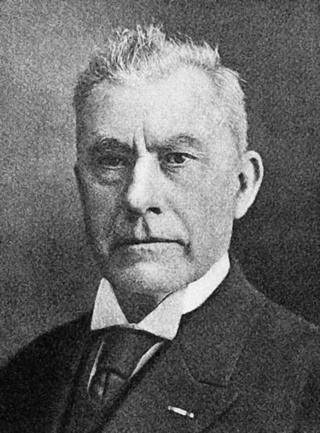
Martinus Willem Beijerinck was a Dutch microbiologist and botanist who was one of the founders of virology and environmental microbiology. He is credited with the co-discovery of viruses (1898), which he called "contagium vivum fluidum".

Sir Aaron Klug was a British biophysicist and chemist. He was a winner of the 1982 Nobel Prize in Chemistry for his development of crystallographic electron microscopy and his structural elucidation of biologically important nucleic acid-protein complexes.

Plant viruses are viruses that affect plants. Like all other viruses, plant viruses are obligate intracellular parasites that do not have the molecular machinery to replicate without a host. Plant viruses can be pathogenic to vascular plants.

Plasmodesmata are microscopic channels which traverse the cell walls of plant cells and some algal cells, enabling transport and communication between them. Plasmodesmata evolved independently in several lineages, and species that have these structures include members of the Charophyceae, Charales, Coleochaetales and Phaeophyceae, as well as all embryophytes, better known as land plants. Unlike animal cells, almost every plant cell is surrounded by a polysaccharide cell wall. Neighbouring plant cells are therefore separated by a pair of cell walls and the intervening middle lamella, forming an extracellular domain known as the apoplast. Although cell walls are permeable to small soluble proteins and other solutes, plasmodesmata enable direct, regulated, symplastic transport of substances between cells. There are two forms of plasmodesmata: primary plasmodesmata, which are formed during cell division, and secondary plasmodesmata, which can form between mature cells.
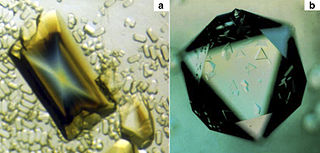
Tobacco virtovirus 1, informally called Tobacco mosaic satellite virus, Satellite tobacco mosaic virus (STMV), or tobacco mosaic satellite virus, is a satellite virus first reported in Nicotiana glauca from southern California, U.S.. Its genome consists of linear positive-sense single-stranded RNA.
M. R. N. Murthy, was a professor of molecular biophysics at the Indian Institute of Science, IISc, Bangalore. He currently teaches at the Institute of Bioinformatics and Applied Biotechnology, Bengaluru. His chief contributions are in the area of X-ray crystallography. He was awarded the Shanti Swarup Bhatnagar award for outstanding contribution to physical sciences, which is the highest honour for a scientist in India, in the year 1992.
Robley Cook Williams was an early biophysicist and virologist. He served as the first president of the Biophysical Society.
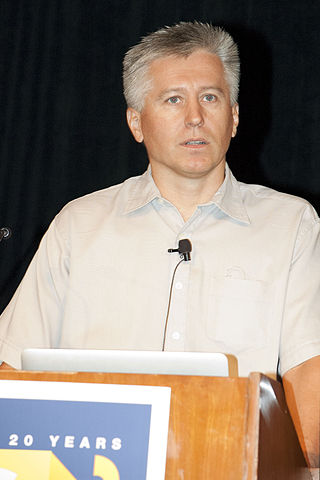
Andrej Šali is a computational structural biologist. Since 2003, he has been Professor in the Department of Bioengineering and Therapeutic Sciences at University of California, San Francisco. He also serves as an editor of the journal Structure.

The term macromolecular assembly (MA) refers to massive chemical structures such as viruses and non-biologic nanoparticles, cellular organelles and membranes and ribosomes, etc. that are complex mixtures of polypeptide, polynucleotide, polysaccharide or other polymeric macromolecules. They are generally of more than one of these types, and the mixtures are defined spatially, and with regard to their underlying chemical composition and structure. Macromolecules are found in living and nonliving things, and are composed of many hundreds or thousands of atoms held together by covalent bonds; they are often characterized by repeating units. Assemblies of these can likewise be biologic or non-biologic, though the MA term is more commonly applied in biology, and the term supramolecular assembly is more often applied in non-biologic contexts. MAs of macromolecules are held in their defined forms by non-covalent intermolecular interactions, and can be in either non-repeating structures, or in repeating linear, circular, spiral, or other patterns. The process by which MAs are formed has been termed molecular self-assembly, a term especially applied in non-biologic contexts. A wide variety of physical/biophysical, chemical/biochemical, and computational methods exist for the study of MA; given the scale of MAs, efforts to elaborate their composition and structure and discern mechanisms underlying their functions are at the forefront of modern structure science.
Satyabrata Sarkar,, was a scientist, investigating physiological phenomena in plants and then studying the structure and function of plant-pathogenic viruses in the Max-Planck-Institute for Biology in Tübingen and at the University of Hohenheim in Germany. Later on he was teaching Bengali language and literature in the Department of Indology of the University of Tübingen. On 11 December 2022 he died aged 94.
Narayanaswamy Srinivasan was an Indian molecular biophysicist and a professor and the head of Proteins: Structure, Function and Evolutionary Group at the Molecular Biophysics Unit of the Indian Institute of Science. He is known for his researches in the fields of computational genomics and protein structure analysis. An elected fellow of the Indian Academy of Sciences and the National Academy of Sciences, India, he is a J. C. Bose National fellow of the Department of Biotechnology and a recipient of the National Bioscience Award for Career Development of the Department of Science and Technology. The Council of Scientific and Industrial Research, the apex agency of the Government of India for scientific research, awarded him the Shanti Swarup Bhatnagar Prize for Science and Technology, one of the highest Indian science awards, in 2007, for his contributions to biological sciences.
Virus nanotechnology is the use of viruses as a source of nanoparticles for biomedical purposes. Viruses are made up of a genome and a capsid; and some viruses are enveloped. Most virus capsids measure between 20-500 nm in diameter. Because of their nanometer size dimensions, viruses have been considered as naturally occurring nanoparticles. Virus nanoparticles have been subject to the nanoscience and nanoengineering disciplines. Viruses can be regarded as prefabricated nanoparticles. Many different viruses have been studied for various applications in nanotechnology: for example, mammalian viruses are being developed as vectors for gene delivery, and bacteriophages and plant viruses have been used in drug delivery and imaging applications as well as in vaccines and immunotherapy intervention.
Peter Francis Cecil Gilbert is an English neuroscientist and biophysicist. He is known for his pioneering work on motor learning in the cerebellum.
Paul Joseph Kaesberg was a German-born American biochemist and virologist who was known worldwide for his extensive research regarding small viruses. His research significantly contributed to the our overall understanding of viruses today. Kaesberg is also known for discovering icosahedral-shaped viruses and for using X-rays to study viruses.
Timothy John Richmond is a Swiss/American molecular biologist, biochemist, and biophysicist.
References
- 1 2 Cohen, Carolyn (November 9, 2007). "Seeing and Knowing in Structural Biology". Journal of Biological Chemistry. 282 (45): 32529–32538. doi: 10.1074/jbc.X700001200 . ISSN 0021-9258. PMID 17848543.
- ↑ "Donald L.D Caspar". Dignity Memorial. Retrieved December 3, 2021.
- 1 2 "Don Caspar". Oral History Collection. Cold Spring Harbor Laboratory. Retrieved January 21, 2015.
- 1 2 "Donald Caspar". World Science Festival. Science Festival Foundation. Retrieved January 21, 2015.
- 1 2 "Donald L. D. Caspar". Florida State University.
- ↑ "Donald L. D. Caspar". Brandeis University. Archived from the original on January 21, 2015. Retrieved January 21, 2015.
- ↑ "Donald L. D. Caspar". Academic Tree. Retrieved January 21, 2015.
- ↑ Franklin, RE (1956). "Structure of Tobacco Mosaic Virus: Location of the Ribonucleic Acid in the Tobacco Mosaic Virus Particle". Nature. 177 (4516): 928–930. doi:10.1038/177928b0. S2CID 4167638.
- ↑ Casper, D. L. D. (1956). "Structure of Tobacco Mosaic Virus: Radial Density Distribution in the Tobacco Mosaic Virus Particle". Nature. 177 (4516): 928. doi: 10.1038/177928a0 . S2CID 30394190.
- ↑ Maddox, Brenda (2003). Rosalind Franklin: The Dark Lady of DNA. London: HarperCollins. p. 269. ISBN 0-00-655211-0.
- ↑ "Aaron Klug – Biographical". Nobel Media. Retrieved January 21, 2015.
- ↑ Caspar DL, Klug A (1962). "Physical principles in the construction of regular viruses". Cold Spring Harbor Symposia on Quantitative Biology. 27: 1–24. doi:10.1101/sqb.1962.027.001.005. PMID 14019094.
- ↑ "Donald L. D. Caspar". John Simon Guggenheim Memorial Foundation. Archived from the original on January 21, 2015. Retrieved January 21, 2015.
- ↑ "Donald L. D. Caspar". National Academy of Sciences. Retrieved January 21, 2015.
- ↑ "Fellow of the Biophysical Society Award". Biophysical Society. Retrieved January 21, 2015.